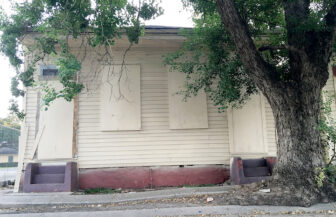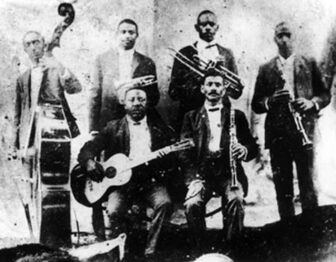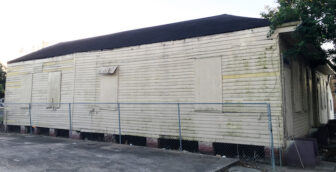Around the turn of the 20th century, a 20-something Central City cornet player combined ragtime and blues in a new way that signaled a shift from what had come before. There was not a word for it then but that would change in a few years when someone hit upon calling the music what we know it as today: jazz.
The cornet player’s name was Buddy Bolden and for much of his career he lived with his mother and sister at 2309 First St. He played his last gig on Labor Day 110 years ago and spent the last 25 years of his life in a Louisiana mental hospital where he died in 1931.
The house on First Street is still there, but there is not even a plaque. It sits abandoned and boarded up, the victim, like so many other historical structures in the birthplace of jazz, of absentee owners. If they give a plug nickel about the building’s role in the history of American music, it is certainly not evident.
Central City is in the throes of gentrification and properties are being snapped up at record prices. But don’t hold your breath waiting to see 2309 First St. restored to glory. The owners for the past eight years have made it clear they have no plans to sell.
While the poor who have long occupied this neighborhood are forced out by encroaching “progress,” the Bolden house sits rotting.
No, it’s not a case of a homeowner who couldn’t afford to rebuild after the storm or a working class family forced out by rising property taxes. Rather, these owners are well-heeled and pay no taxes at all. So why is this landmark in the history of America’s most distinctive and original contribution to world culture dilapidated and unoccupied?
To answer that question a trip to church is in order. No, the answer won’t be delivered by divine revelation. It’s on the balance sheet of the Greater St. Stephen Full Gospel Baptist Church, once the largest congregation in the city.
The megachurch, run by and Bishop Paul Morton and his wife, Pastor Debra Morton, bought the building in 2008. It stands on a triangular portion of property which the Greater St. Stephen also owns adjacent to their burned out church at First and Liberty.
And there’s the irony.
People who heard Bolden said he combined the music of the “holy roller” churches of the area, mixed gospel with the sound of a wind band ensemble and, according to bandleader Kid Ory and other contemporaries, created jazz.

The influence of sacred music on Bolden’s breakthrough sound has been documented countless times, most notably in Donald M. Marquis’ groundbreaking 1978 book, “In Search of Buddy Bolden: First Man in Jazz.”
You might think Greater St. Stephen would be more respectful of this heritage. Bishop Morton made bank in the gospel music business and the congregation has been generous to him as well, making the church anything but a struggling institution. Further, Greater St. Stephen received over $5 million in federal block grants to create “affordable housing” according to a 2013 audit.
So why is Buddy Bolden’s house in the state it’s in?
When confronted by this paradox in 2014, a spokesperson for the church assured the New Orleans Advocate that action was at hand.
“We don’t need anybody to save the day,” Angela Young said. “We’re going to pay homage to Buddy Bolden, an African American-musician, and we’re going to do it properly.”
“We want to bring the Bolden house back into commerce, and we are exploring how to document the influence of spiritual music and the music of Buddy Bolden’s day,” she said. “We want to honor it. And we’re going to do it by doing more than putting a plaque on the home.”
That was two years ago. No renovations have taken place and, based on a call this week, nothing is planned in the immediate future. There’s still not even a plaque.
Greater St. Stephen, which began beefing up its Atlanta presence after Hurricane Katrina, leaving Debra Morton in charge of New Orleans operations, was cited in 2011 and again in 2014 for demolition by neglect of the Bolden home. They paid about $500 in fines. No, that’s not a typo. It’s a pittance.

Morton’s son, P.J. Morton of the Maroon Five pop rock band, is now listed as a cultural ambassador for the Bring Back the Eagle Saloon initiative which aims to save a building on South Rampart Street where Bolden regularly performed. Apparently it’s easier to see the speck in another’s eye than the plank in one’s own.
While Louis Armstrong’s birthplace now sits under our traffic court building and his childhood home under City Hall, further dithering on the Bolden home all but assures that this birthplace of jazz will one day be nothing more than a reserved spot for the mega-church leaders to park their fancy cars. Maybe they will see fit to set a plaque in the pavement.
John McCusker is a New Orleans native and retired photojournalist. He is the author of “Creole Trombone: Kid Ory and the Early Years of Jazz” and founder of the Cradle of Jazz History Tour. He can be reached at ory1886@yahoo.com



